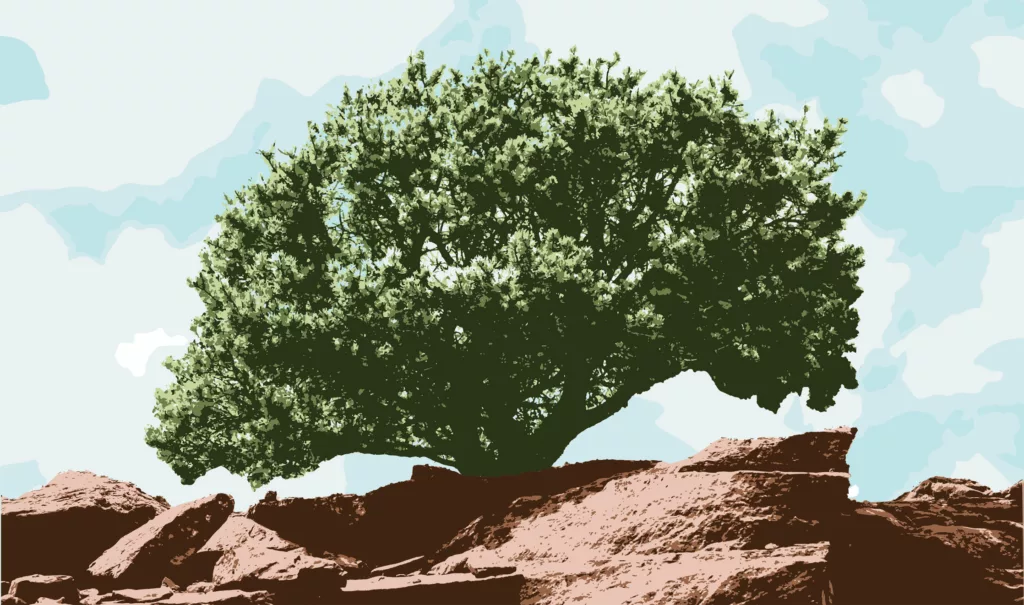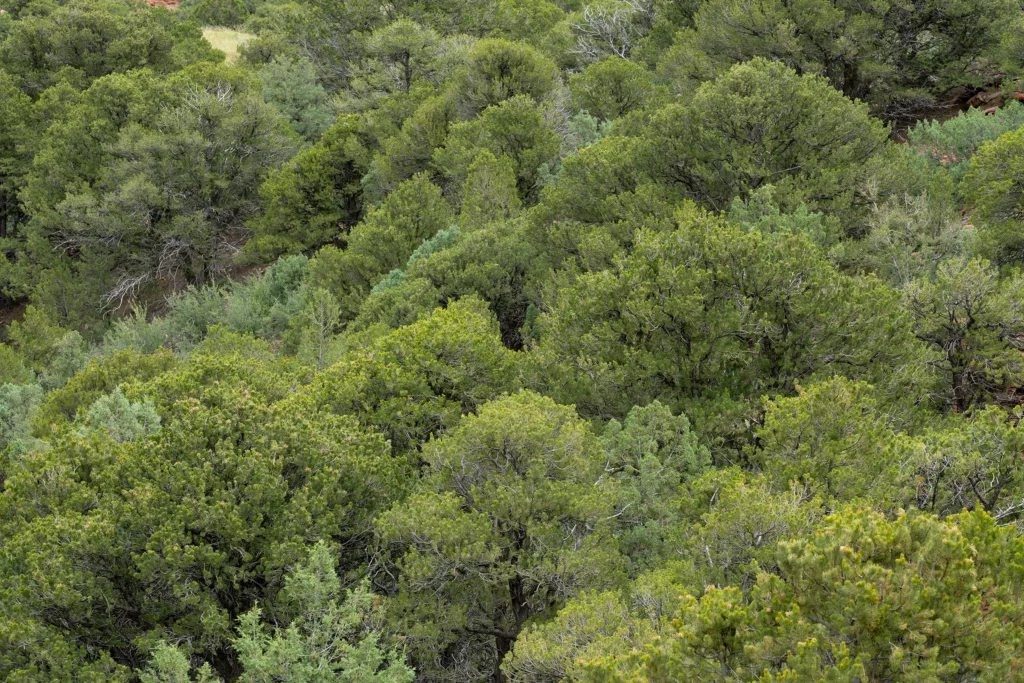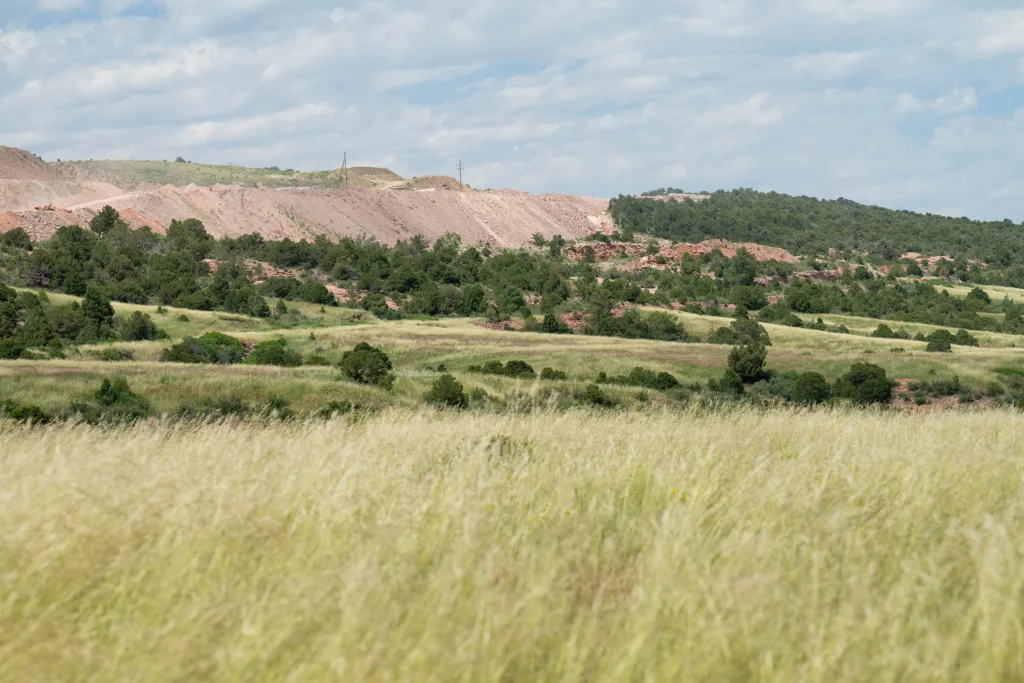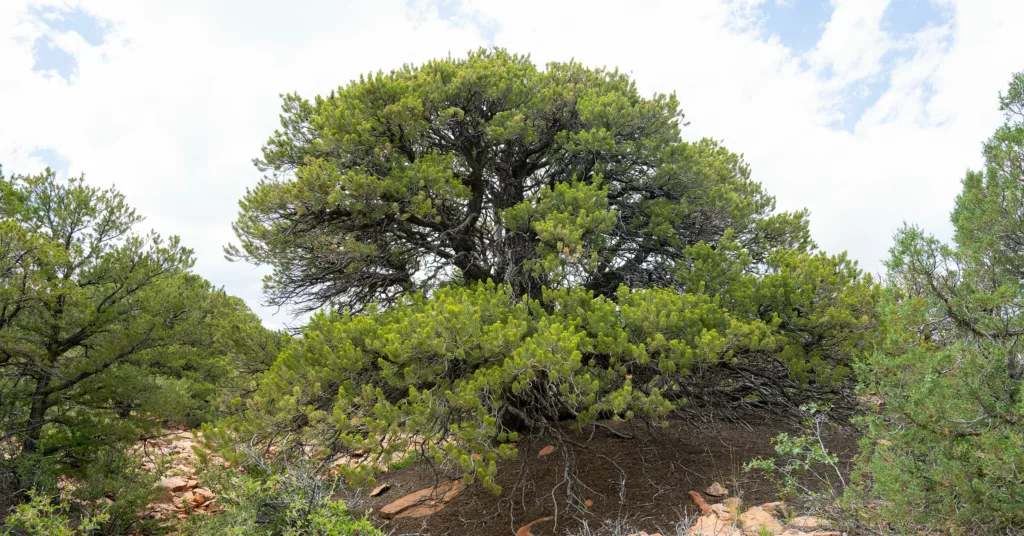It’s not quite like finding palm trees in Poudre Canyon, but the piñon pines dotting a ridge just off U.S. Highway 287, 20 miles northwest of Fort Collins, offer a mystery that has intrigued foresters and anthropologists for nearly a century. This grove of tubby pines along Owl Canyon is separated by 150 miles from the next closest stand of piñons. So, how the heck did it get there?
But there’s more to the story of the wayward trees. The piñon grove was the subject of a decades-long tussle involving a Colorado business, a mining company, CSU faculty, state agencies, and fired-up locals. Why all the hoopla? The piñon pines in Owl Canyon grow atop a valuable mineral resource, a layer of high-grade limestone that generates significant royalty income for public schools in Colorado; quarrying that limestone also “quarries” the unique grove of piñon pines.

A keystone tree
The Colorado piñon pine, Pinus edulis, is a keystone tree of the American Southwest. Piñon forests spread across 37 million acres in Colorado, Utah, Arizona, and New Mexico, extending into small areas of Nevada, Wyoming, Texas, and California. Northeastern Colorado is well outside the species’ range. The closest piñon country is around Colorado Springs, making the Owl Canyon grove the most northeasterly stand of piñons in North America.
Both humans and wildlife are fans of piñons. Indigenous and Hispanic communities have gathered piñon nuts for centuries, and their harvest and preparation are cherished cultural traditions. In the 1950s, Colorado A&M zoology Professor Richard Beidleman and his students surveyed the local piñon grove, finding 95 species of non-avian vertebrates and 76 bird species living in its confines.

A mystery, and a threat
In the 1930s, a Colorado A&M forestry professor exploring Owl Canyon came upon the out-of-place grove of pines. The canyon had been described in an 1878 land survey as containing scattered cedars, spruce, and a heavy growth of piñon pines. The forestry professor recognized how unusual it was for Pinus edulis to be growing so far north of its range and in such a precarious location.
Much of the piñon grove, which stretches in a half-mile-wide swath for three miles along the ridge, is owned and administered by the Colorado State Land Board. At statehood in 1876, Colorado received 4 million acres of federal land to help fund public schools, including the 30,000 acres granted to support the state agricultural college (now CSU) under the Morrill Act. These “school lands” were to be leased or sold “in the manner which will secure the maximum possible amount therefore.”
And secure they do. In the last 15 years, SLB lands statewide have earned $2 billion. Currently 99% of all SLB revenue goes to public K-12 schools, including revenue from the Owl Canyon limestone quarry, which is still in operation under a lease to a private company.
As the state’s land-grant university, CSU receives the remaining 1%, which it splits with seven other beneficiaries. According to Kristin Kemp, SLB outreach and communications officer, in fiscal year 2021-22, CSU received $742,544 of lease revenue from 66 parcels statewide, but none from the Owl Canyon quarry.
The piñon trees at Owl Canyon had little monetary value but the rich deposit of limestone beneath them did. In 1924, the SLB granted a lease to Holly Sugar to quarry the limestone, used in the manufacture of beet sugar.
In its first 40 years, the Owl Canyon quarry produced 900,000 tons of limestone and paid the school fund $119,830 in royalties. In the past 10 years, royalties from the quarry amounted to $390,000.
Because the limestone is near the surface, the soil and minerals are removed from the top down, destroying the piñons in the process. By 1962 the grove, originally estimated to cover 250 acres, was down to 153 acres.

‘Plea for the Pinyon Grove’
Destruction of the piñon grove did not sit well with the local community. In 1931, Livermore Woman’s Club member Mary Aldrich composed “Plea for the Pinyon Grove,” which she read at a meeting of the club. The club formed a Pinyon Committee, and in 1951 held a field day at the grove, gathering 500 signatures on a petition for the governor to protect it as a public preserve.
However, guided by the “secure the maximum possible amount therefore” mandate, SLB president A.M. Ramsey said, “It wouldn’t be profitable to give it up.” In a letter to the Pinyon Committee he wrote, “So far as this board is concerned, this issue is as dead as the prehistoric men who were supposed to have inhabited that territory. All I can say is, that if they did, they chose a very unromantic spot.”
Undaunted, the piñon proponents, supported by CSU faculty, pivoted to designating the grove a state park. Forestry professor JVK Wagar, namesake of the Wagar Building on the Oval, spoke in favor of the idea. He took his students on field trips to the grove each spring and led public “show me” tours. (The grove is now accessible to the public by permit only.)
“This area certainly deserves state park status,” he said. “It is a unique area, not duplicated anywhere in the United States.” Zoology Professor Beidleman lent his expertise and C.H. Wasser, forestry college dean, prepared recommendations “for the preservation of as many trees as possible.”
But in 1961, the Land Board kiboshed the state park idea: “It is plainly the duty of the Land Board to see that the quarrying operation continues and that no obstacles should be put in the way of the operation.”

Finally … protection
Despite the SLB policy, public passion to protect the piñons didn’t wane. Mentions of their age and majesty cropped up in newspaper accounts, one story dubbing a massive pine “The Patriarch.” “Grove of the Ancients” trumpeted another.
Eventually, the mission to preserve the grove succeeded. In 1978, with the sugar beet industry in decline, Holly Sugar agreed to relinquish 101.2 acres of its mineral lease. CSU leased the site “for research, study, and protective purposes” then entered into an agreement with the newly designated Colorado Natural Areas Program, now under Colorado Parks and Wildlife, to protect it as a state natural area.
Established in 1977, CNAP protects places with rare plants, endangered species, and other unique natural features. Owl Canyon Pinyon Grove Natural Area was one of the first areas included, its 603 acres encompassing the SLB land plus adjacent CPW and private land.
Note: In 1996, SLB’s mandate changed from maximizing income to producing “reasonable and consistent income over time.” A Stewardship Trust now protects some SLB lands that contain natural values such as scenic beauty, wildlife habitat, and historic features.
“Owl Canyon was one of the first properties designated,” explains Lindsay Brandt, SLB stewardship trust manager, “for the piñon pines’ ethno-botanical features.”
Though SLB’s Stewardship Trust was still nearly two decades in the future, Brandt says, the piñon grove’s preservation 45 years ago was in the public interest. “Holly Sugar was willing to forego mining the area because everybody felt it was important to keep the grove unmined.”

But how’d they get there?!
The mystery of how the piñons got so far from “home” persists. Were they a relict stand from an ancient, widespread piñon forest? Did birds carry the seeds there? Did First Coloradans plant them?
“The grove is filled with archaeological sites,” explains Jason LaBelle, CSU anthropology professor and director of the Center for Mountain and Plains Archaeology. “This hogback area, along that corridor from north of Cheyenne all the way down to Pueblo, is a chosen place for people to live.”
In 1936, a Denver Museum of Natural History team found dozens of points, flakes, and tools at the site, dating them to Folsom Period people some 12,000 years ago. In 1973, CSU anthropology Professor Robert Burgess identified 60 habitation sites there, dating them to 7,000 years ago. But did human use of Owl Canyon predate the piñon trees?
In the 1950s, University of Colorado graduate student Charles Wright used core samples to determine that the piñons had started growing around 1570 A.D., making the grove about 400 years old. A 1991 study headed by Julio L. Betancourt of the U.S. Geological Survey, which looked at pollen and material in packrat middens – accumulations of sticks, rocks, and “stuff” – within the tree stand, pushed that date back.
“Our 5,000-year pollen and macrofossil record suggests that pinyon pine colonized the site sometime between 1290 and 420 years B.P. (700 A.D. to 1570 A.D.).” It concluded the grove developed after long-distance dispersal rather than being a relict woodland.
LaBelle pushes the likely date of piñon establishment even earlier. Excavation of a shallow alcove found pottery, arrow points, food remains, and piñon residue in fire pits. “The earliest date of piñon charcoal there is Common Era 670 (1,350 years ago). That is the oldest evidence of piñons in that area.”
It is unlikely birds or animals transported the heavy seeds 150 miles from the closest piñon stand, so did the early Coloradans who burned piñon wood also plant the seeds?
“The evidence is inconclusive for the trees being intentionally planted,” says LaBelle. “In northeast Colorado, there is almost zero evidence of farming at that time.” Nomadic people would have carried pine nuts, an easily transported food, and undoubtedly lost some when they camped.
“Whether carried there or cultivated,” says LaBelle, “proving Native American dispersal is difficult.”
The mystery of Owl Canyon’s piñon pine grove remains, but Richard Knight, CSU professor emeritus of wildlife conservation, celebrates its value. “Sitting at the north end of the Colorado Front Range, the pinyon grove north of Fort Collins is a significant natural attraction, both for its human and its natural history. … Truly a gem in a friendly setting, the pinyon grove helps all of us value our interdependency on thriving natural landscapes.”